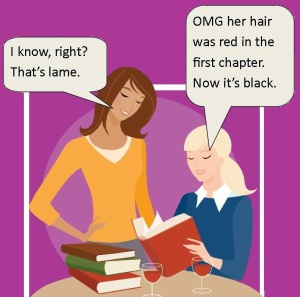This has nothing to do with becoming an evil professor that
gives a ridiculous amount of homework that is all due the next day. No, I’m referring
to those books that keep you reading into the wee hours of the morning because
you just can’t put them down.
The tips from this session came
from a long-time book editor named Lorin Oberweger. She actually handed out a
detailed sheet with her own method and rating sheet, but I’m just going to give
you some of her general tips. I don’t know if her method is copyrighted or not,
so I won’t go into it. If you want to look into taking one of her awesome
sessions, though, you can find out more about her here.
So let’s get started:
#1. Out with the Old, in with the New
Readers are excited when they’re given a new way of looking
at things. Be original with your story and put something fresh out there. “But
how?” you say. “There are so many stories out there. The one I want to tell is
probably already written!”
I don’t know about you, but I don’t totally buy into that
phrase, “There’s nothing new under the sun.” It just sounds like an excuse to
not be creative. Sure, there are going to be unoriginal pieces in your writing, but what will make your work one-of-a-kind
is how you manipulate those pieces and make them into a brand new whole. Write about a murder from the perspective of
the victim’s ghost or place your story in prehistoric times but give everyone
cellphones. Use your book as a kaleidoscope that readers can look through to
see their ordinary world differently.
#2. Action vs. Reaction
I used to come up with these fast-paced plots that I was so
excited to write, but when it came time to sit down and begin, I found that my
main characters were dull and flat. Every time. I couldn’t figure out where I’d
gone wrong when I had such a riveting story line planned out. Then, one of my
friends pointed out that my protagonist wasn’t causing any of the action but
was simply being carried along by the events in the story and reacting to what
others were doing.
Don’t make the same mistake I did for the longest time. Make
sure your main characters are actively engaging
in the story. Have them make bold choices or stupid mistakes that alter where
the plot goes. The character may not have caused the inciting incident, but the
rest of the story should be about the actions they take to reach their ultimate
goal that was set in motion by that incident. To make sure that your character
is being active, ask yourself this: If I took away the external conflicts and
obstacles, would my character be doing anything?
 |
| In one of the best movies of all time, Starlord kicks off the movie by making a choice that affects the rest of the plot. He steals the mysterious glowy ball for himself and everyone comes after him. |
#3. FOR SPARTA!!!!!!
Another way to make sure that your characters are exciting
and well-rounded is to give them clear goals that motivate their actions. If
you set up an important desire for your character that he’s determined to
accomplish, readers are more likely to keep reading to see if he succeeds. You
can also use a more tangible goal of completing something concrete to symbolize
the character getting what he wants internally.
For example, let’s say my character is a guy named Hank Girlyman.
He decides he’s going to be the ultimate wrestling champion, no matter what it
takes. He goes through a lot of unfortunate (and hilarious) attempts but he
never gives up, despite the impossible odds. In the end, he loses, but he’s
gained the respect of many people. He’s still happy even though he failed, because
what the wrestling champion goal really represented was his desire to be seen
as a manly man and to be respected. Yay Hank!
 |
| Hank Girlyman is manly. |
#4. The Reader Connection
Okay. I know I’m starting to sound like a broken record with
how much I’m talking about characters, but they’re sort of an important part of
the story. So here’s another tidbit to work on with anyone you put into your book.
Use lots and lots of emotion. I don’t mean, “Marcy felt afraid as she walked
through the woods.” I don’t want to be told
that she’s afraid. I want to be shown
so that I can feel it too. “As she crept through the woods, the hairs on the
back of Marcy’s neck stood up and she felt a tingling sensation down her spine,
as if a thousand spiders were crawling down her back.” See the difference?
People read stories because it’s the closest they can come
to living in another time or possessing magical powers. They want to be the characters and not just see them.
Lorin Oberweger pointed out that books should be less passive than movies. In
books, we can get inside a character’s head and experience things through their
eyes, instead of just watching things happen to someone else.
 |
| Someday we'll find it, the reader connection, the readers, the writers, and meeeeeee! |
#5. Be a Drama Queen
That’s right, I said be
a drama queen. Writing and acting are probably the only two places where you’ll
hear that. (By the way, have you ever noticed that writing is basically acting
for introverts?) What I mean by that is that you shouldn’t be too afraid about
giving your characters too much emotion. Open yourself up and let it out. Just
like with makeup for actors on stage, you have to lay your characters’ emotions
on thick for anyone to really notice them. What seems overdone to us is
probably not the case for the reader.
Remember what I said about motivating characters with strong
goals? Since they cling to these goals so dearly, they’re likely to have some
pretty extreme reactions when things bring them closer to or further away from
their dreams. Make them throw things or cry or laugh uncontrollably. But
remember: show, don’t tell.
 |
| What do you mean there's no milk left? I've already poured the cereal! All I wanted was a fulfilling breakfast. My life is over! |
#6. The Eye of the Beholder
Beauty is in the eye of the beholder, which means that one
person’s perspective is different from another’s, and that’s another great way
to bring some excitement into your story. Give your characters unique ways of
looking at things and demonstrate their diverse personalities through strong
voice. Your writing voice should be a combination of the character’s emotion,
language, and perspective.
Lorin actually had some really good exercises for practicing
different voices. First, she said to take your opening scene and practice
re-writing it in a different emotion, such as fear, anger, or anxiety. The more
you emphasize your character emotion, the stronger your voice. She also said
you could practice writing one setting from multiple perspectives. Maybe
Tabitha thinks of the mansion as a big fairy-tale castle while her father just
thinks of it as a big lonely house with a lot of empty rooms. Feel free to
share what you come up with in the comments. I definitely want to try these on
my own stories!


















